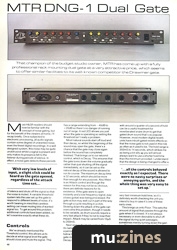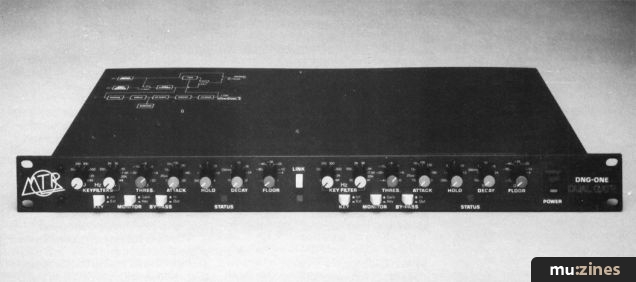Magazine Archive
Home -> Magazines -> Issues -> Articles in this issue -> View
MTR DNG-1 Dual Gate | |
Article from Home & Studio Recording, June 1986 | |
MTR have designed their own pro noise gate and it turns in a very convincing performance.
That champion of the budget studio owner, MTR has come up with a fully professional rack mounting dual gate at a very attractive price, which seems to offer similar facilities to its well-known competitor the Drawmer gate.

Most H&SR readers should now be familiar with the concept of noise gating, but for the benefit of the viewers at home, I'll recap briefly. Once subjected to electronic processing, all audio signals contain some degree of unwanted noise, even the finest digital recordings. In a well designed system, this noise may be quite unobtrusive whilst a signal is present and only makes its presence felt to the listener during periods of silence. In effect, a noise gate detects these periods of silence and shuts off the signal so that the noise is muted. A variable threshold system lets the user set up the gate to respond to different levels of noise, it's worth bearing in mind that careless setting can mean muting bits of wanted signal too. To get around this problem, additional controls have been added, so let's examine exactly what these do.
Controls
We've already mentioned the Threshold control; this allows us to decide at what signal level the gate should close and mute the signal. This has a range extending from -40dB to +20dB so there's no danger of running out of range. A red LED shows you just when the gate is operating so setting the threshold isn't really a problem.
Most natural sounds start off loud and then decay, so whilst the beginning of the sound may open the gate, there's a chance that the gate may close again before the sound has completely finished. That brings us to our second control, which is Decay. This ensures that the gate turns down the volume gradually rather than just shutting off the signal immediately, so it can be set so the natural decay of the sound is allowed to run its course. The maximum decay time is 32 seconds, which should be more than enough for any purpose. Also fitted is an Attack control and though the reason for this may not be so obvious, there are definite reasons for its existence. If the gate were to open instantly and a low frequency signal, (say a bass guitar) was being processed, the gate action may well cut in part of the way through a cycle resulting in a click. Slowing down the attack of the gate can overcome this problem, though it needs to be variable, as drum sounds require a very fast attack if they're not to lose their impact. Attack may be varied from 1OμS to 200mS.
"With very low levels of input, a slight click could be heard as the gate opened, regardless of the attack time set..."
Next stop is the Hold control. This, as its name implies, holds the gate open for a period of time after the signal has fallen below the threshold and then lets the gate close at whatever rate is set by the Decay control. Setting a fast decay time, with around a quarter of a second of hold can be a useful treatment for reverberated snare drum to get that gated drum sound that's so popular. However, most modern digital reverb units have inbuilt gated reverb effects so that the noise gate is not used in this role as often as it used to be. The hold range is 350mS to 14 seconds, which strikes me as being a bit silly as you will almost always want to use a shorter hold time than the minimum provided. I understand that the design is being changed to offer a very fast minimum hold time, so it's definitely worth checking the unit you intend to buy in case it's one of these early ones.
This brings us onto Floor. This sets the amount of signal that passes through the gate when it's closed. It's not always necessary or even desirable to shut off the signal during quiet passages, sometimes merely turning down the gain is sufficient and that's what the Floor control allows you to do. Floor range is —70dB to -1dB.
The Inputs, Outputs and Key inputs are all to be found on the rear panel in the form of ¼" jacks.

Key Filters
Until recently, only the most sophisticated gates sported this feature but it's really very useful. If, for example, you are gating a snare drum mic to remove some of the snare buzz that inevitably seems to follow, it's not uncommon for the nearby hi-hat to trigger the gate, thereby letting the buzz through just when you don't need it. By using both low- and high-pass filters connected into the threshold circuitry, you can set up the filters to allow the snare drum to pass through but to attenuate the high frequencies coming from the hi-hat. Because the filters are in the control circuitry and not in the signal path, the output sound is not changed in any way. By pressing the Monitor button, the output of this filter section is fed to the output so that you can hear the effect of your adjustments whilst setting up. The high-pass filter covers the range 25Hz to 3.6kHz and the low-pass 200Hz to 34kHz.
"...all the controls behaved exactly as I expected. There were no nasty surprises or annoying quirks, and the whole thing was very easy to setup."
Additionally there is an external Key input which enables one instrument to control another. The popular example is to use a bass drum to drive the key input whilst feeding the bass guitar track through the gate. This only lets the bass guitar pass through when there is a bass drum beat thus giving a very tight sound. Other tricks involve using a drum machine voice to trigger the gate enabling you to create rhythmic effects from a sustained sound.
The Bypass switch does as its name suggests enabling you to compare the gated sound with the untreated sound. Using the Link key both channels may be linked for stereo operation.
In Use
The gate worked smoothly with no real problems. With very low levels of input, a slight click could be heard as the gate opened, regardless of the attack time set, but this was not a serious problem. Similarly a little breakthrough was just audible when a signal was applied to the key input with no input to the gate — nothing drastic but it was there.
In bypass mode, there was less output noise than when the gate was in circuit but this was only evident at very high gain settings and would present no problem in practice. I would say that the noise performance of this unit would satisfy most professional requirements with the possible exception of high quality digital recording.
Another aspect of this gate I found attractive was that all the controls behaved exactly as I expected. There were no nasty surprises or annoying quirks, and the whole thing was very easy to set up.
"...the control pots have very thin, brittle shafts which do not stand up to abuse; the first two review models arrived with knobs broken off."
Conclusions
This is a very flexible gate useful in both a creative and a corrective context and is very sensibly priced when its sound quality, professional facilities and ease of operation are taken into account.
One criticism of the unit though is that the control pots have very thin, brittle shafts which do not stand up to abuse; the first two review models arrived with knobs broken off. MTR really should consider changing this component as in its present state, I couldn't recommend the unit for use on the road unless extravagantly flight-cased.
In terms of performance, once the Hold range problem has been sorted out, and possibly a little attention given to the control breakthrough problem, I will have no hesitation in recommending this gate as a very worthwhile investment for any studio. What's more, this one's built in Britain so wave the flag and buy one.
The MTR DNG-1 Noise Gate costs £274 including VAT.
Further details are available from: MTR, (Contact Details).
Also featuring gear in this article
MTR DNG-One (Dual Noise Gate)
(IT Dec 86)
MTR DNG-ONE Dual Gate
(SOS Aug 86)
MTR Dual Noise Gate - Studio Test
(IM Jul 86)
Browse category: Studio/Rack FX > MTR
Publisher: Home & Studio Recording - Music Maker Publications (UK), Future Publishing.
The current copyright owner/s of this content may differ from the originally published copyright notice.
More details on copyright ownership...
Review by Paul White
Help Support The Things You Love
mu:zines is the result of thousands of hours of effort, and will require many thousands more going forward to reach our goals of getting all this content online.
If you value this resource, you can support this project - it really helps!
Donations for April 2024
Issues donated this month: 0
New issues that have been donated or scanned for us this month.
Funds donated this month: £7.00
All donations and support are gratefully appreciated - thank you.
Magazines Needed - Can You Help?
Do you have any of these magazine issues?
If so, and you can donate, lend or scan them to help complete our archive, please get in touch via the Contribute page - thanks!









